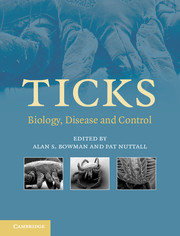Book contents
- Frontmatter
- Contents
- List of contributors
- Preface
- 1 Systematics and evolution of ticks with a list of valid genus and species names
- 2 The impact of tick ecology on pathogen transmission dynamics
- 3 Tick salivary glands: the physiology of tick water balance and their role in pathogen trafficking and transmission
- 4 Tick saliva: from pharmacology and biochemistry to transcriptome analysis and functional genomics
- 5 Tick toxins: perspectives on paralysis and other forms of toxicoses caused by ticks
- 6 Tick lectins and fibrinogen-related proteins
- 7 Endocrinology of tick development and reproduction
- 8 Factors that determine sperm precedence in ticks, spiders and insects: a comparative study
- 9 Tick immunobiology
- 10 Saliva-assisted transmission of tick-borne pathogens
- 11 Lyme borreliosis in Europe and North America
- 12 Viruses transmitted by ticks
- 13 Babesiosis of cattle
- 14 Theileria: life cycle stages associated with the ixodid tick vector
- 15 Characterization of the tick–pathogen–host interface of the tick-borne rickettsia Anaplasma marginale
- 16 Emerging and emergent tick-borne infections
- 17 Analysing and predicting the occurrence of ticks and tick-borne diseases using GIS
- 18 Acaricides for controlling ticks on cattle and the problem of acaricide resistance
- 19 Anti-tick vaccines
- 20 Anti-tick biological control agents: assessment and future perspectives
- 21 Pheromones and other semiochemicals of ticks and their use in tick control
- Index
- References
1 - Systematics and evolution of ticks with a list of valid genus and species names
Published online by Cambridge University Press: 21 August 2009
- Frontmatter
- Contents
- List of contributors
- Preface
- 1 Systematics and evolution of ticks with a list of valid genus and species names
- 2 The impact of tick ecology on pathogen transmission dynamics
- 3 Tick salivary glands: the physiology of tick water balance and their role in pathogen trafficking and transmission
- 4 Tick saliva: from pharmacology and biochemistry to transcriptome analysis and functional genomics
- 5 Tick toxins: perspectives on paralysis and other forms of toxicoses caused by ticks
- 6 Tick lectins and fibrinogen-related proteins
- 7 Endocrinology of tick development and reproduction
- 8 Factors that determine sperm precedence in ticks, spiders and insects: a comparative study
- 9 Tick immunobiology
- 10 Saliva-assisted transmission of tick-borne pathogens
- 11 Lyme borreliosis in Europe and North America
- 12 Viruses transmitted by ticks
- 13 Babesiosis of cattle
- 14 Theileria: life cycle stages associated with the ixodid tick vector
- 15 Characterization of the tick–pathogen–host interface of the tick-borne rickettsia Anaplasma marginale
- 16 Emerging and emergent tick-borne infections
- 17 Analysing and predicting the occurrence of ticks and tick-borne diseases using GIS
- 18 Acaricides for controlling ticks on cattle and the problem of acaricide resistance
- 19 Anti-tick vaccines
- 20 Anti-tick biological control agents: assessment and future perspectives
- 21 Pheromones and other semiochemicals of ticks and their use in tick control
- Index
- References
Summary
In recent years there has been much progress in our understanding of the phylogeny and evolution of ticks, in particular the hard ticks (Ixodidae). Indeed, a consensus about the phylogeny of the hard ticks has emerged which is quite different to the working hypothesis of 10 years ago. Several changes to the nomenclature of ticks have been made or are likely to be made in the near future. One subfamily, the Hyalomminae, should be sunk, while another, the Bothriocrotoninae, has been created (Klompen, Dobson & Barker, 2002). Bothriocrotoninae, and its sole genus Bothriocroton, have been created to house an early-diverging (‘basal’) lineage of endemic Australasian ticks that used to be in the genus Aponomma. The remaining species of the genus Aponomma have been moved to the genus Amblyomma. Thus, the name Aponomma is no longer a valid genus name. The genus Rhipicephalus is paraphyletic with respect to the genus Boophilus. Thus, the genus Boophilus has become a subgenus of the genus Rhipicephalus (Murrell & Barker, 2003). Knowledge of the phylogenetic relationships of ticks has also provided new insights into the evolution of ornateness and of their life cycles, and has allowed the historical zoogeography of ticks to be studied. Finally, we present a list of the valid genus and species names of ticks as at Febuary 2007.
INTRODUCTION
Hoogstraal & Aeschlimann (1982) were apparently the first people to publish a phylogenetic tree for the ticks (suborder Ixodida); however, hypotheses about the evolutionary relationships of ticks had been proposed well before this (e.g. Pomerantsev, 1948; Camicas & Morel, 1977).
- Type
- Chapter
- Information
- TicksBiology, Disease and Control, pp. 1 - 39Publisher: Cambridge University PressPrint publication year: 2008
References
- 21
- Cited by

